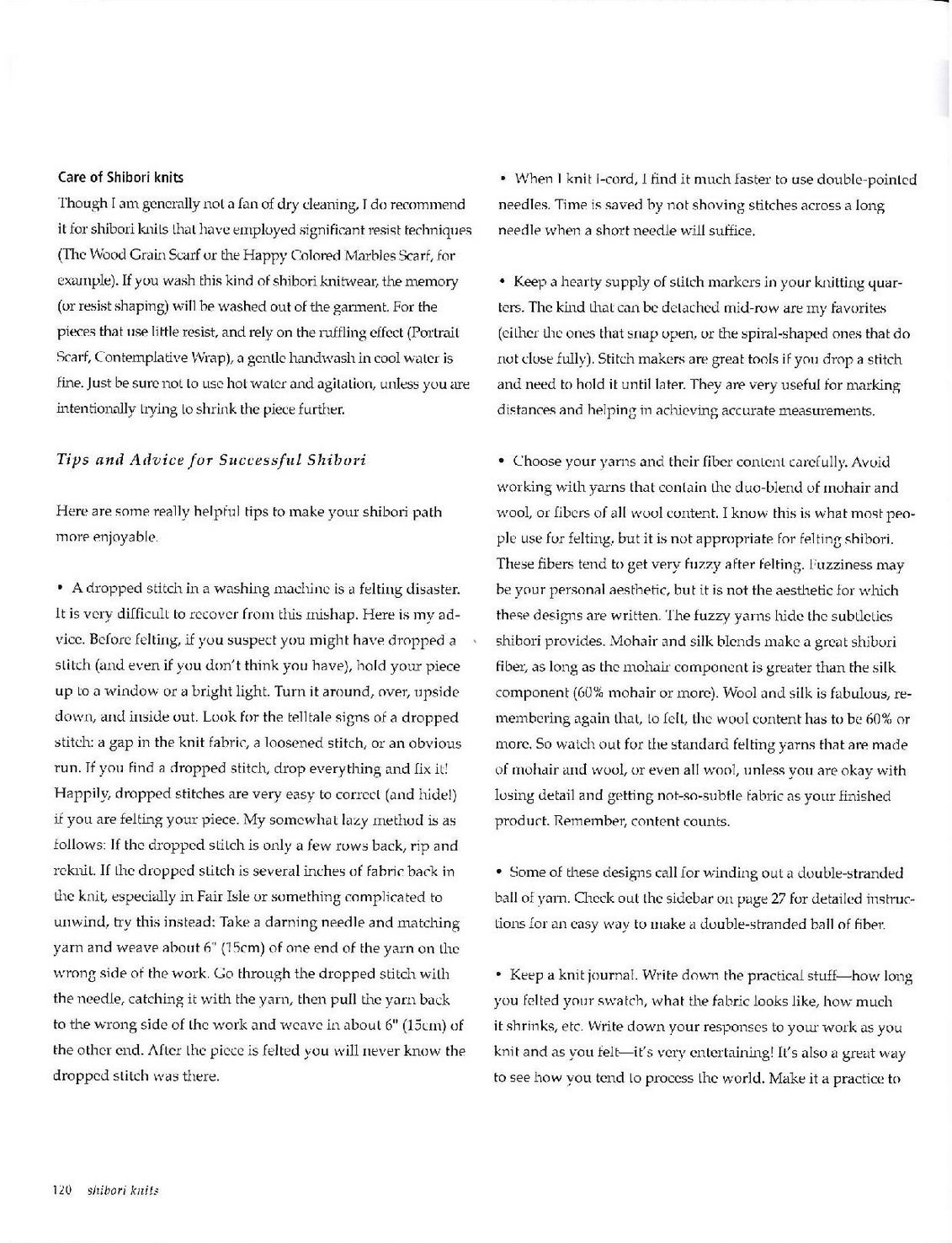S20C 409120813441

Care of Shibori knits
Though I am gcnerally nol a fan of dry deaning, I do rerom mend U for shibori knils Ihal have employed signifieant resist techniques (The Wbod Cr diii Sairf or the Happy Colored Mar bies Scarf, For example). If you wash this kind of shibori knitwear, the memory (or resist shaping) will be washed out of tire garment. For the pieoes that use little resist, and rely on the ruf f ling effcct (Portrail Scarf, Contempiative Wrap), a gcnllc handwash in cool walcr is fine. Just be suro not lo use hol walor and agilalion, unless you are intentionally trying lo shrink the piece further.
Tips and Advice fur Suctessful Shibori
Hero are some really helpful tips to make your shibori path morę enjoyable.
* A dropped sticdr in a washing machino i$ a feltiug disaster. it is very difficull lo rccovcr froni this inishap. Here is my ad-vioe. Bcforc feltiug, if you suspect you might have dropped a slitch (and even if you don't think you have), hołd your piece up lo a window or a brigłit light. Tum it around, over, upside down, and inside out. Look for the tell tale signs of a dropped stitch: a gap in the' knit fabric, a loosened stitch, or an obvious run. Tf you find a dropped stitch, drop everything and fix it! Happily, dropped stitches are very easy to correct (and hicie!) if you are feiting your piece. My somcwhal lazy method is as iollows: If the dropped stitch is ordy a few rows back, np and rcknil. If tire dropped slitch is several inches of fahne back in tire knit, especially in Fair Isle or something complicated to unwind, try this instead: Take a darning needle and matching yarn and weave about 6" (łbem) of one end of the yarn on the wrong side of the work. Co through the dropped stitclr willi the needle, catching it with the yarn, then puli tire yarn back to the wrong side of the work and wcavc in about 6” (15un) of the other end. Aflcr the piece is felted you will never know the dropped slitch was there.
• When I knit l-cord, i find it nr uch las ter to use double-poinlcd needles. Time is saved by not shoving stitches across a iong needle when a short needle will suffice.
• Keep a hearty supply of slitch markers in your knilting quar-ters. The kiird llral can bc delached rnid-row are my favorites (cillrcr the ones that snap open, or the spiral-shaped ones that do not duse fully). Stitch makers am great tools if you drop a stitch and need to hołd it until la ter. They are very useful for marking distances and helping in aclrieving accurate measurements.
• Choose your yams and their fiber conlcnl carcfuily. Avoid working with yams that conlain tire duo-blend of mohair and wool, or fibers of all wool conterrt I know this is what most peo-ple use for feiting.. but it is not appropriate for feiting shibori. These fibers tend to get very fuzzy after feiting. I uzziness may be your personal aesthetic, but it is not the aesthetic for which these designs are written. The fuzzy yams Iride the subllclics shibori provides. Mohair and silk blcnds make a great shibori fiber, as long as the mohair componcnt is greuter than the silk component (60% mohair or moro). Wool and silk is fabulous, re-nrenrbering again llral, lo fell, the wool eon tent has to bc 60% or nrorc. So walch out for lite standard feiting yams that are madę of mohair and wool, or even all won!, unless you are okay with losing detail and getting not-so-subfle ta brie as your finished product. Kemem ber, content counts.
• Some of tirese designs cali lor winding out a double-stranded bali of yarn. Qrcck out the sidebar on puge 27 for detailed instruo lioirs lor an easy way to make a double-stranded hall of fiber.
• Keep a knit journal. Write down the practicai stuff-—how long you fol ted your swa Ich, what the f a brie looks like, how much
it shrinks, etc. Write down your responses to your work as you knit and as you lelt—it's vcry entcrtainiirg! lt's also a great way to see how you tend lo proccss liro world. Make it a practice to
120 sitibori knils
Wyszukiwarka
Podobne podstrony:
S20C 409120813433 appendix Lechnical Shibori Fetting Concepts lmportanl generał diaracterishcs of sh
S20C 409120813433 appendix Lechnical Shibori Fetting Concepts lmportanl generał diaracterishcs of sh
S20C 409120813433 appendix Lechnical Shibori Fetting Concepts lmportanl generał diaracterishcs of sh
S20C 409120813160 surrender to shibori Buuquet Wrap 20 Happy Colored Marbles Scarf 24 Wood Grain Sca
12621 S20C 409120813161 surrender to shiborielegant explorations in shibori possibility This rhapter
11 3 General rules taking care of the voice • do not exert your voice for too long
36204 S20C 409120813233 shibori creatiińtyexperiments in unlikely combinations of fibe Włiile Chapte
S20C 409120813231 Shibori Cred tivi ty expares the harmonious blending of felting and nonłelting fib
S20C 409120813320 shibori fez The Shibori Fez represents one of myfirsl Irue success stones in thepr
więcej podobnych podstron